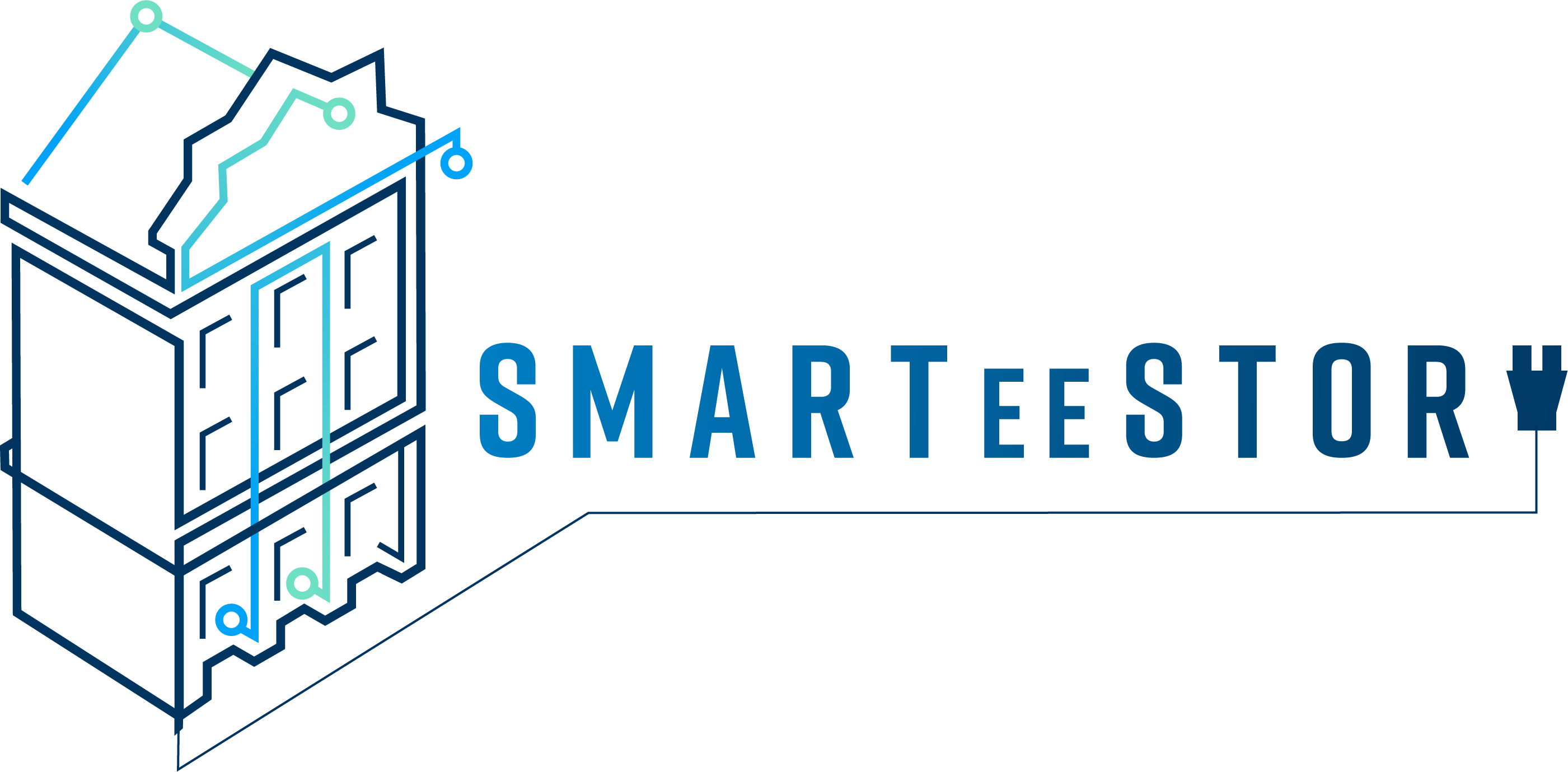Riga launches pre-intervention monitoring campaign at City Hall
The Riga City Hall is the main administrative building of the Riga City Municipality and is located in the heart of Riga’s Historic Centre, a UNESCO World Heritage Site. As part of the SMARTeeSTORY project, in preparation for future system upgrades, the municipality has installed the building management system components supplied by the SMARTeeSTORY partners Schneider Electric and TERA, including the sensors for measuring temperature, humidity and CO2 levels and the weather station.
Advancing Energy Efficiency in a Historic Landmark
Improving the energy performance of historic buildings requires balancing conservation with modern upgrades. Through the SMARTeeSTORY project, the City of Riga aims to improve the energy efficiency of Riga City Hall by focusing on the optimisation and monitoring of indoor climate conditions. The intervention targets the 4th to 8th floors of the City Hall Building A, which contain occupied spaces and have therefore been designated as the project’s intervention zones. These areas are prioritised due to their direct impact on occupant comfort and wellbeing.
The installation phase followed an extensive planning process, including the completion of executive designs, pre-monitoring preparations, and the acquisition of all required approvals. Works were carried out with minimal disruption to building occupants, ensuring smooth integration of the new systems.
With the installation now complete, the pre-intervention monitoring campaign will be launched following the configuration and commissioning of the monitoring system by the SMARTeeSTORY technical partners. The data collected through the pre-intervention monitoring phase will enable project partners to carry out future energy optimisation and support informed decision-making.
About the Riga City Hall
Riga, as Mission City, has set the goal of becoming a climate-neutral city by 2030. Today, Riga City Hall serves multiple representative functions, hosting the offices of the Mayor and elected councillors, as well as assembly halls and conference facilities. Since 2022, following the outbreak of the war in Ukraine, part of the building has been made available to the Ukrainian community as a gathering space and support centre for war refugees.
The Riga City Hall is the main administrative building of the Riga City Municipality and is located in the heart of Riga’s Historic Centre, a UNESCO World Heritage Site. The Historic Town Hall originally was built in 1848-1850 by the famous Riga City Architect Johann Daniel Felsko, however, it was destroyed by bombing during World War II. The current building is a replica of the original building, constructed in 2004, following the medieval pattern.
As part of the SMARTeeSTORY project, Riga Technical University created a detailed digital version of Riga City Hall, known as a BIM (Building Information Model). It focused on one part of the building called Building A. This digital model was based on real-life measurements taken on site, laser scanning, and historical records. The work followed a special planning guide provided by the project partner CARTIF.
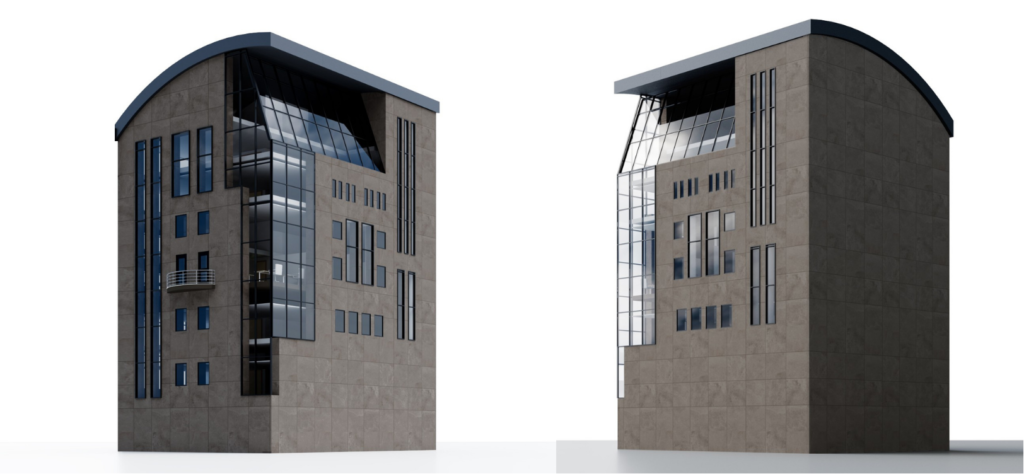
The complexity of the process lay in accurately modelling the building’s geometry and in the fact that Building A was constructed over an existing structure, which was reused as a structural core. This made it difficult to determine the precise thickness and composition of the original walls, requiring careful interpretation and informed assumptions during the modelling process, particularly as the project’s main focus was to achieve accurate area and volume calculations for the monitoring and analysis of indoor climate conditions.
Building A consists of eight floors, of which the 4th to 8th floors contains occupied spaces and are therefore defined as the intervention zones of the project. These areas are the primary focus for improving and monitoring indoor climate conditions, as they directly affect human comfort and wellbeing.
The digital model includes two versions of the building: one showing its current condition and another showing how it will look after intervention. This makes it possible to clearly see the impact of the project’s actions.
Riga aims to become a climate-neutral city by 2030. The BIM model will serve as a baseline for the future modernization of the entire building, supporting its transformation towards climate neutrality and providing a practical example of how historic public buildings can contribute to achieving Riga’s 2030 sustainability objectives.
About the Riga City Hall today
Nowadays the building has a number of representative functions, from hosting the offices of Riga Mayor and other elected councillors to assembly premises and conference rooms. In 2022, since the beginning of the war in Ukraine, part of the building has been handed over to Ukrainian community to be used as a gathering space and support centre for war refugees.
Riga’s climate action is now recognized across Europe! The capital of Latvia – Riga – has joined 91 other EU towns and cities that have demonstrated a strong commitment to climate action through rigorous plans approved by the European Commission.
“The Mission Label is an important European recognition that confirms – Riga’s climate plan is reliable, aligned with EU goals, and implementable. It is not just a symbolic award – this assessment opens doors to international collaboration, additional funding, and expert support that, like the SMARTeeSTORY project, will help implement many new, highly innovative climate-smart development projects in our city. This opportunity will bring significant benefits, help renew aging infrastructure, including the historical heritage buildings, green the city, and improve air quality, but it will require everyone’s involvement – both from the municipality and from the residents,”
- emphasizes Nika Kotoviča, SMARTeeSTORY Project's local Demo Site Coordinator and Urban Planning Expert from the Riga Municipal Agency “Riga Energy Agency”. Alongside the demos at Delft and Granada, the SMARTeeSTORY pilot at Riga City Hall is already demonstrating how smart building technologies can be deployed in historic settings to reduce emissions, improve energy efficiency, and engage citizens in sustainable transformation.
The Mission Label has now found a permanent place at Riga’s City Hall, receiving applause from the city administration and local politicians:
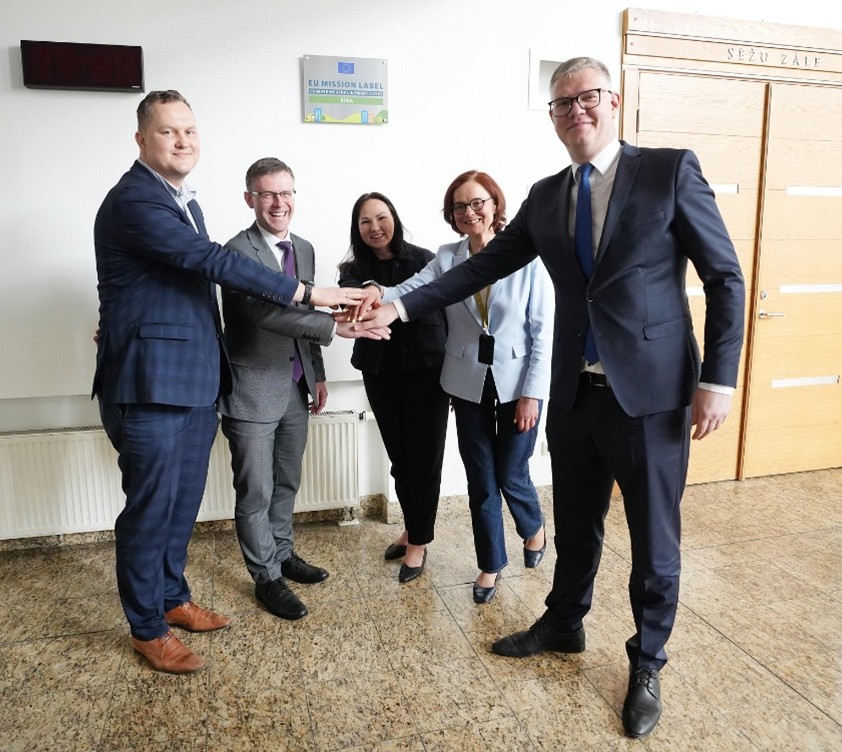
In essence, the urban climate-neutrality mission implies 80% greenhouse gas emission reduction by 2030 compared to 1990. This ambition can be only achieved by phasing-out fossil fuel use in energy generation, buildings and transportation as well as mitigating emissions from waste management and land use.
The recognition granted by Mission Label opens new windows for further development:
- Access to funding – Riga gains access to additional funding from EU funds, the European Investment Bank, and other strategic projects, such as the recent deal with the municipal forestry company “Rīgas Meži,”.
- Support for innovation – the city can apply for special “Horizon Europe” programs specifically designed for these 92 cities, including grants for pilot projects and the implementation of innovative solutions.
- International recognition – Riga strengthens its position internationally as one of the leaders in the field of sustainable and climate-smart development.
Riga's climate neutrality plan
The planned emission reduction measures are grouped into four main sectors: transport, energy production, municipal infrastructure, and multi-apartment housing. The plans include adoption of Riga’s Circular Economy Plan, citywide greening initiatives, transportation system transformation, and energy production improvements through expanding electrification and energy efficiency measures.
Zooming in to Riga’s municipal infrastructure, the reduction in emissions in this area should contribute to 7% of total reductions by 2030. Key actions include the renovation of public buildings, switching to renewable energy resources, the use of zero-emission vehicles, and energy-efficient street lighting. The renovation of multi-apartment buildings is projected to contribute 2% to the total reduction, with the potential for greater impact depending on the citywide pace of energy efficiency implementation.
Looking ahead
Many action areas and measures are already underway. However, a great deal of work lies ahead, including addressing an investment gap and ensuring the highly critical intensive coordination, adequate human resources, and sustained political will. The delivery of these efforts in the multi-sectoral and comprehensive strategy for economically viable GHG emissions reduction are key for the commitment.
Despite some uncertainties, Riga remains fully committed to benefiting from and contributing to the Climate Mission. With Riga's key strengths in its experience and expertise, developed through international cooperation in projects like SMARTeeSTORY, the city is eager to reach its targets and showcase climate neutrality in action.
Find out more about the EU Mission: Climate-neutral and smart cities - Research and innovation
Apart from recent steps forward in the technicalities of the smart technology implementations, the Riga team has been actively engaging with stakeholders and industry partners to promote sustainable retrofitting practices. The demonstrator's progress was showcased at local roundtables with SMEs and technology providers, raising awareness and fostering collaboration.
Dissemination and Stakeholder Engagement
Over the past six months, RTU has focused on academic training and industry outreach to share SMARTeeSTORY’s advancements. Key activities included participation in Erasmus Staff Teaching and Training Mobility programs, where RTU presented the project’s latest findings at major education and training events:
- October 2024: Faculty of Civil & Mechanical Engineering, University of Ljubljana, Slovenia
- November 2024: National University of Agadir, Morocco
At both cases, the historical building context is of particular attention and relevance.
These sessions introduced SMARTeeSTORY’s retrofitting technologies, energy performance strategies, and smart sustainability principles to university students and faculty members, ensuring the project's impact extends into future research and academic curricula.

A guest lecture and a panel discussion on the energy efficiency aspects in historical building context, keynote speaker: A. Prozuments (RTU). ENA Agadir, Morocco – November 2024.
Academic and Industry Collaboration
In addition to academic dissemination, RTU also organized a special seminar in November 2024 titled “Modern Solutions for Energy-Efficient Historical Buildings”. This session brought together academia, researchers, and industrial groups to discuss biomethane, solar panels, and other sustainable technologies, integrating SMARTeeSTORY’s insights into the broader conversation on energy efficiency in historic buildings. The event drew participation from SMEs and large technology providers, highlighting the project’s relevance to real-world applications in the industry.
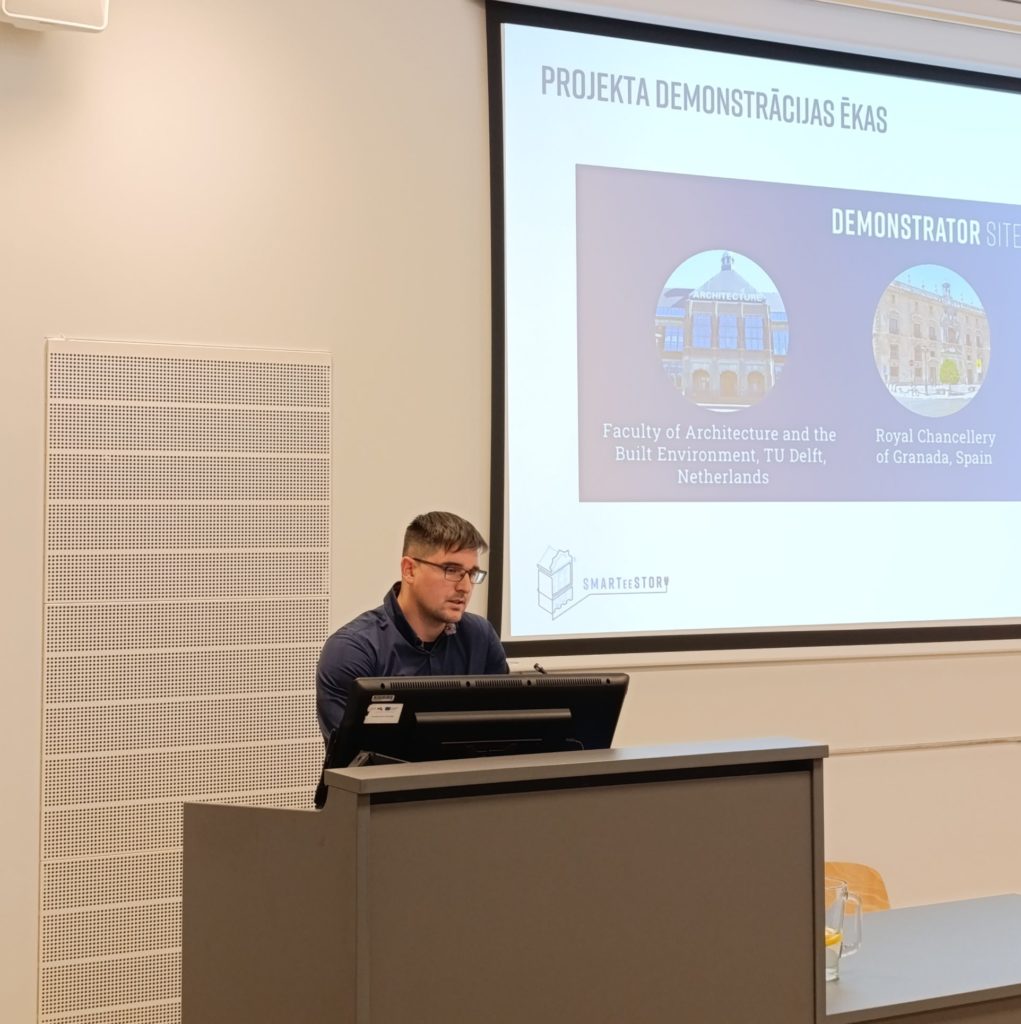
RTU seminar, workshop organized by the Institute of Sustainable Building Materials and Engineering Systems on Building energy efficiency. A chapter on historical building renovation, speaker: A. Prozuments (RTU). RTU Riga, Latvia – December 2024.
Educational Integration
In addition, RTU is actively integrating the findings from the Riga City Hall demonstrator into its academic curriculum. The insights gained from the thermal comfort assessments, smart control systems, and energy efficiency improvements are being incorporated into engineering and architecture courses, providing students with real-world case studies on sustainable retrofitting in heritage buildings. This academic integration ensures that the demonstrator’s impact extends beyond the project itself, fostering long-term innovation in the field of smart and sustainable building retrofits.
Through these activities, RTU has successfully positioned the SMARTeeSTORY Riga demonstrator as a reference point for sustainable retrofitting education and industry best practices, ensuring knowledge and findings are actively shared and applied across multiple sectors.
Riga City Hall is undergoing a transformation employing a detailed analysis to guide the retrofitting efforts. Demo partners REA and Riga Technical University with the consortium partners are working hard to lay down all the ‘blueprints’ for the installations to come.
Achievements and Progress
• Permit Acquisition: Successfully obtained the necessary approvals for installation and material use.
• Collaborative Planning: Finalized hardware and communication architectures and designated the final demonstration area.
• Material and Access Approvals: Approved the materials list and arranged all necessary access permits.
• Solution Design: Final installation design to ensure accurate measurement of parameters and effective equipment control, overcoming challenges related to communication capabilities.
The past months have been marked by energy performance assessments, procurement finalization, and stakeholder engagement. Enhancing the energy performance of a historic government building required a comprehensive energy assessment. The Riga team developed a Baseline Energy Performance Certificate to identify inefficiencies and guide retrofitting efforts.
Combining Heritage with Sustainable Energy
One of the most exciting recent developments is the integration of Building Integrated Photovoltaic (BIPV) systems. These systems will provide sustainable energy while preserving the architectural integrity of the structure. During installation, the location of the BIPV installation had to be adapted to better meet the energy needs of the building. This shift ensures maximum efficiency while remaining within the constraints of the historical preservation requirements.
As the photovoltaics installations move forward, smart blinds optimizing indoor lighting and temperature regulation are being developed by PELLINI to improve energy efficiency.
Winter Thermal Comfort Monitoring & Environmental Analysis
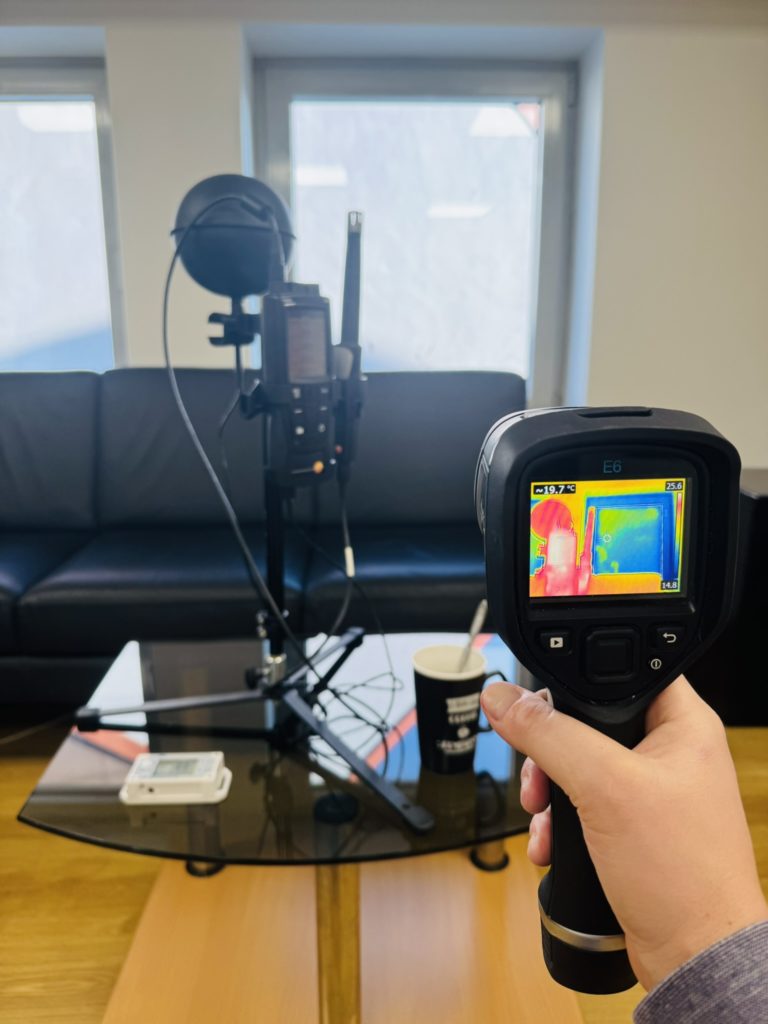
In February 2025, the RTU team conducted winter indoor thermal comfort monitoring at Riga City Hall at 5 floors each featuring different works station setup. Spot measurements were done over 2 winter days between 9 AM till 4 PM, hourly across 10 work stations. The team analyzed temperature differences across surfaces and work stations during working hours by measuring:
- Ambient air temperature,
- Globe temperature,
- Relative humidity,
- CO2 concentration,
- Vertical illuminance,
- Surface temperatures (nearest façade/outdoor facing wall, window frame, desk, floor, ceiling).
These comprehensive measurements help identify thermal asymmetry and indoor environmental quality issues. This information is important for assessing the user comfort and optimizing energy efficiency strategies.
This allowed the pinpointing of localized discomfort caused by:
- cold radiation from exterior walls,
- uneven heating distribution, or
- excessive solar gains near windows
Continuous measurements were also conducted over 24 hours to measure the variability in temperature, humidity, and CO2 levels at two work stations.
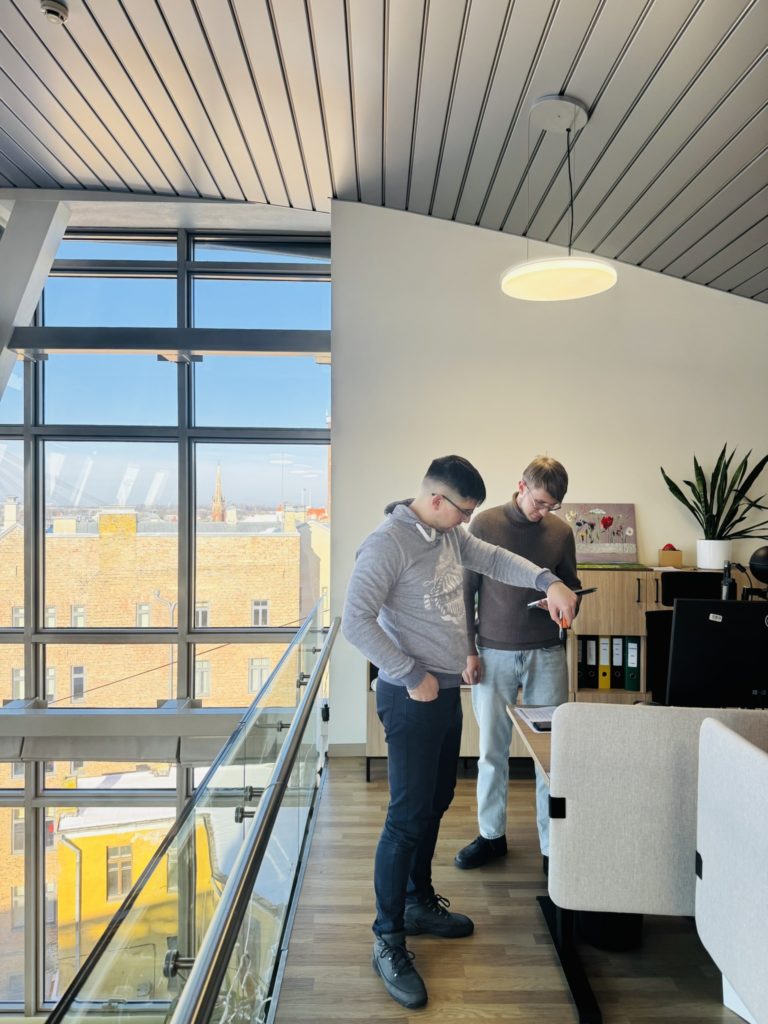
Next Steps: Installations & Performance Optimization
With significant progress made in planning and procurement, the next six months will focus on:
- completing procurement and installation of devices and sensors, including BIPV and smart blinds
- Full-scale deployment of sensors
- Live data collection to track energy savings and comfort improvements
The last step signifies the shift towards data collection and performance optimization. This way, the project team can systematically evaluate the impact of retrofitting measures on energy consumption and indoor environmental quality at Riga City Hall.
Beyond technical advancements, knowledge sharing remains a key priority. Findings from the Riga City Hall demonstrator will contribute to a scientific publication, adding to global research on energy-efficient retrofits for historic buildings. Additional outreach and dissemination initiatives will ensure that these insights benefit local municipalities, European energy policymakers, and sustainability practitioners.
With significant progress already made, the Riga City Hall project is poised to serve as an example of how smart technologies can enhance the sustainability of Europe’s historic architecture—without compromising its heritage.
Riga City Hall (Rātsnams), located in the historic old town of Riga (a UNESCO heritage site), serves as the main administrative building for the Riga city municipality. Originally built in the mid-19th century and reconstructed in 2004, the City Hall is now a crucial part of the SMARTeeSTORY project. Alongside various specialized EU partners and the research team at Riga Technical University's Institute of Sustainable Building Materials and Engineering Systems (RTU), the city is working to significantly improve the building’s energy efficiency and smartness.
The main project goals are:
- Upgrade heating, cooling, ventilation, lighting, and shading systems.
- Integrate Building-Integrated Photovoltaics (BIPV) for renewable energy.
- Implement the SMARTeeSTORY energy management system.
An extensive energy audit conducted in late 2023/early 2024, which included a comprehensive analysis of heating, ventilation, and air conditioning (HVAC) systems, highlighted areas for efficiency improvements. The energy consumption data from 2017 to 2022 showed significant variations, and based on the audit findings, the following measures were proposed:
- Adding a 200 mm thermal insulation layer to the uninsulated exterior wall facing the unheated tower space to achieve a thermal transmittance value of U=0.14 W/m²K.
- Installing energy-efficient glazed constructions, including solar glazing on selected floors, to enhance airtightness and reduce infiltration.
- Upgrading the HVAC systems based on technical survey recommendations to ensure proper operation and substantial energy savings while maintaining optimal indoor environmental conditions.
- Replacing all lights with energy-efficient LED solutions.
Substantial peaks in heating energy consumption during colder months indicate significant potential for savings through the proposed measures. Implementing these solutions is expected to substantially reduce the building's primary energy consumption and carbon footprint.
The energy audits provided valuable data on the building's energy performance, highlighting areas for improvement. A meeting at the end of February 2024 with involved project stakeholders—Riga City council project coordinators, RTU, energy auditors, as well as invited architects and consultants—discussed and outlined further steps of action.
The ongoing demo activities at Riga City Hall demonstrate how historic buildings can be retrofitted with modern, energy-efficient technologies while preserving their architectural heritage.
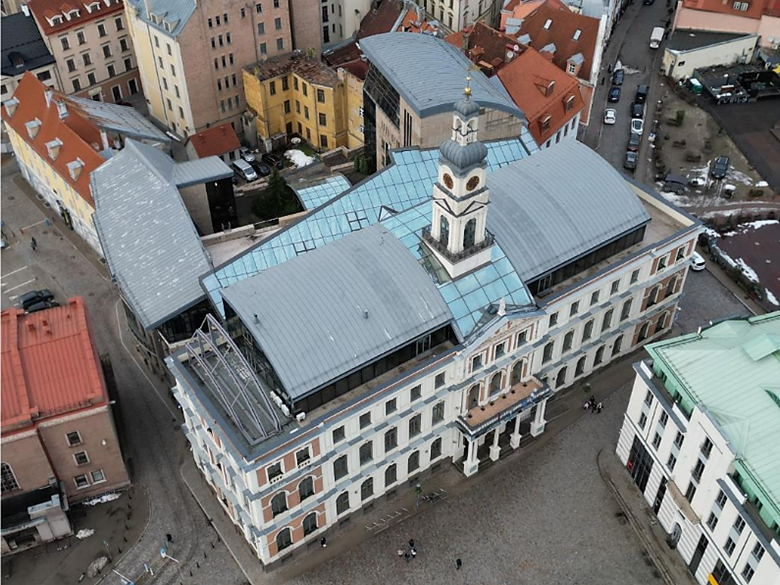
Subscribe to our newsletter


